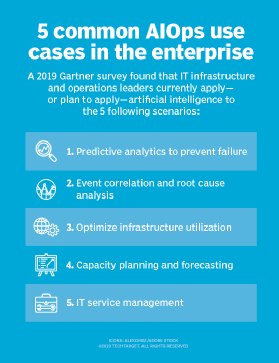putilov_denis - stock.adobe.com
Build AI into the DevOps maturity model for smooth sailing
AI has promising applications in DevOps, but organizations must account for the maturity of their teams, processes and tools to ensure the success of their AI initiatives.
AI-augmented DevOps aims to simulate human intelligence with computer systems and apply it to DevOps toolchains and processes.
A DevOps team can take advantage of AI for common automation and monitoring tasks, such as container scanning, code quality checks, and observability and reporting improvements. Just as DevOps maturity models can help enterprises navigate their DevOps transformations, keeping certain milestones in mind can smooth AI integration into DevOps pipelines.
Phase 1: Pre-AI
Before adopting an AI-powered DevOps tool, perform due diligence on the available options, and educate internal stakeholders and IT teams about AI's benefits.
Conduct research internally and externally
As with many promising technologies, some tool vendors take liberties in defining AI. To cut through the marketing speak, focus on some of the real-world use cases for AI in DevOps:
- Autosuggest code snippets in real time to improve developer productivity.
- Autogenerate and run test cases based on a codebase's attributes.
- Proactively assess the health of CI/CD pipelines with predictive analytics.
- Improve feedback and alert management across pipelines.
- Use deep learning and data mining to accelerate DevOps workflows.
Separate facts from hype by researching your organization's normal channels, reviewing customer case studies and interviewing internal DevOps teams to understand their AI requirements. Document these requirements in a technical brief to distribute to stakeholders and IT teams working on the AI transformation.
In addition, consider stances on AI within DevOps teams and across the organization as a whole. Despite AI's positive implications when it comes to code quality and developer productivity, there are also controversies -- for example, engineers' concerns that the code completion tool GitHub Copilot could propagate programming errors by learning from developers' mistakes.

Identify use cases for AI in DevOps
The analysis and research phase should result in a use case -- such as monitoring DevOps pipelines with predictive analytics -- that meets the organization's requirements and can dictate the focus moving into production.
Explain the benefits of AI to IT teams and executives
Major cloud service providers and other vendors, such as Digital.ai, are beginning to integrate AI into their DevOps tools. However, it's still important to convey the advantages of AI to IT teams.
Even if an organization has some early AI adopters, not everyone will be on board right away. Set expectations with IT teams about AI's potential to positively affect the DevOps lifecycle, emphasizing increased productivity and reduced manual and rote work.
Pitching AI adoption to executive leadership requires a different tone. Here are some tips to help an AI-augmented DevOps maturity model resonate with senior management:
- Make sure executives understand the basics. Provide a high-level explainer of what AI in DevOps is -- and isn't.
- Describe AI's potential to strengthen the organization's security and compliance practices.
- Outline some possible metrics and reporting improvements AI could bring to DevOps toolchains.
Phase 2: Early-stage AI adoption
To start executing AI in DevOps environments, choose a pilot project and refine IT team collaboration in light of new data.
Pilot projects -- a standard part of DevOps transformations -- are also significant milestones when adding AI to DevOps pipelines. Choose a small pilot project designed to stress-test developers' requirements for AI and DevOps. Factor some learning time into the schedule to put AI tools through their paces.
Refine data and information collaboration
Adding AI to DevOps toolchains can improve collaboration within IT teams and offer a bounty of information across development, operations and security.
In some cases, adding new tools requires IT teams to set up and configure new reports to meet organizational requirements. Take the time to explore and iterate on any new reporting options AI provides -- and don't hesitate to get feedback from stakeholders and team members.
Challenge your preconceived progress measurements
Adopting AI might challenge organizations' assumptions on how to measure progress for their DevOps initiatives. IT teams might gain new quality and operations data related to software quality, pipeline health or alert management that they didn't have pre-AI.
During this phase, meet with the people involved to pore over the data that AI tools produce and report. Determine what that data means for stakeholders and work together to eliminate noise.
Phase 3: Full implementation of AI in production
The work isn't over once an organization has integrated AI into DevOps successfully; these initiatives require ongoing, iterative improvements based on lessons learned. As organizations move into the stage of operations and continuous optimization, IT teams must keep learning about and refining their use of AI -- and seek out new DevOps use cases for it.
As more AI-backed DevOps tools emerge, it's only a matter of time before AI becomes an integral part of DevOps maturity assessments. IT teams that understand how to harness their data can gain an advantage in security, compliance and development velocity by augmenting their DevOps toolchains with AI.








